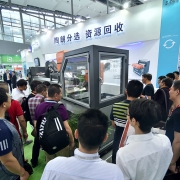BIR World Recycling Convention Week 2020 Stainless Steel & Special Alloys Committee
Stainless consumption decline could be limited to 4% this year, says Markus Moll.
The share of the global stainless steel market claimed by the 300 series would jump from 54.1% in 2019 to 59.3% by 2030, it was reported to the BIR Stainless Steel & Special Alloys Committee’s webinar on October 16. “That means nickel will win and scrap will win,” declared guest speaker Markus Moll, Managing Director of SMR GmbH – Steel and Metals Market Research in Austria.
Global flows of stainless scrap (excluding revert) were calculated to have reached 9.8 million tonnes in 2019, with Mr Moll “surprised” that Europe had still imported more than 250,000 tonnes from Russia/CIS countries (+10% year on year). Approaching 600,000 tonnes of stainless scrap was shipped from Europe to India for an increase of 7% over 2018. But according to feedback from Andre Reinders of Nimomet LLC, major Indian producer Jindal Stainless had reportedly committed to further reducing its reliance on imported raw materials from 65% three years ago to 35% by 2021, with the current figure said to be around 45%.
China’s scrap ratio was just above 20% last year – well short of the 70%-plus and 80%-plus levels recorded by, in turn, Europe and the USA, Mr Moll pointed out. Stainless scrap availability in China – currently at around 3 million tonnes a year – was growing by a minimum of 10% per annum and would continue to be consumed entirely within the domestic market, he contended.
The combined share of global stainless steel production held by China and Indonesia would continue its climb to more than 70% next year, noted Mr Moll. However, he expected this share to begin to plateau in subsequent years, not least because of anti-dumping and anti-subsidy measures adopted by other countries. According to BIR Stainless Steel & Special Alloys Committee Chairman Joost van Kleef of Oryx Stainless BV in the Netherlands, the large proportion of stainless production based on primary nickel had “an enormous negative effect on the CO2 footprint”.
While acknowledging that outcomes in 2021 would be dictated to a significant extent by the depth and duration of the COVID pandemic, Mr Moll ventured as far as to forecast that global stainless steel consumption would leap 11% next year. The current year’s decline would be restricted to 4%, he believed, because of 3% growth in China – easily the world’s largest consumer of stainless steel at more than 21 million tonnes per annum. It was anticipated that consumption drops of 13% in 2020 for both Europe and the USA would be followed by gains of, respectively, 16% and 19% next year. Asia (excluding China) was expected to turn a 2020 consumption decrease of 12% into growth of 22% next year.
In a series of market reports, Mr Van Kleef confirmed that the first three months of 2020 had seen the lowest quarterly stainless steel production figure for three years. But since then, he added, “there has been a slow but steady increase in certain key industries that consume stainless steel”. For Italy, meanwhile, Ruggero Ricco of Nichel Leghe SPA spoke of the scarcity of scrap available to meet mills’ demand.
The US stainless scrap export market had been “extremely poor” in 2020, with January-July shipments some 28% lower than in the same period last year on weaker demand from, among others, Taiwan, India and Canada, reported Doug Kramer of Spectrum Alloys, LLC in the USA.
In his market report for Asia, Vegas Yang of HSKU Raw Material Ltd pointed to strong stainless steel scrap demand in both China and India. And for the Middle East, Omar Al Sharif of Sharif Metals International LLC identified major growth potential for the stainless steel cable ties market.
Commenting on superalloys, Uwe Dierkes of Siegfried Jacob Metallwerke GmbH & Co KG in Germany warned that “uncertain and volatile” market conditions could be expected to persist in the coming months.
Source: BIR (Brussels, 20 October 2020)







